 迷雾花园钢结构栈道和岛状散布的植被 摄影:Holi河狸景观摄影
迷雾花园钢结构栈道和岛状散布的植被 摄影:Holi河狸景观摄影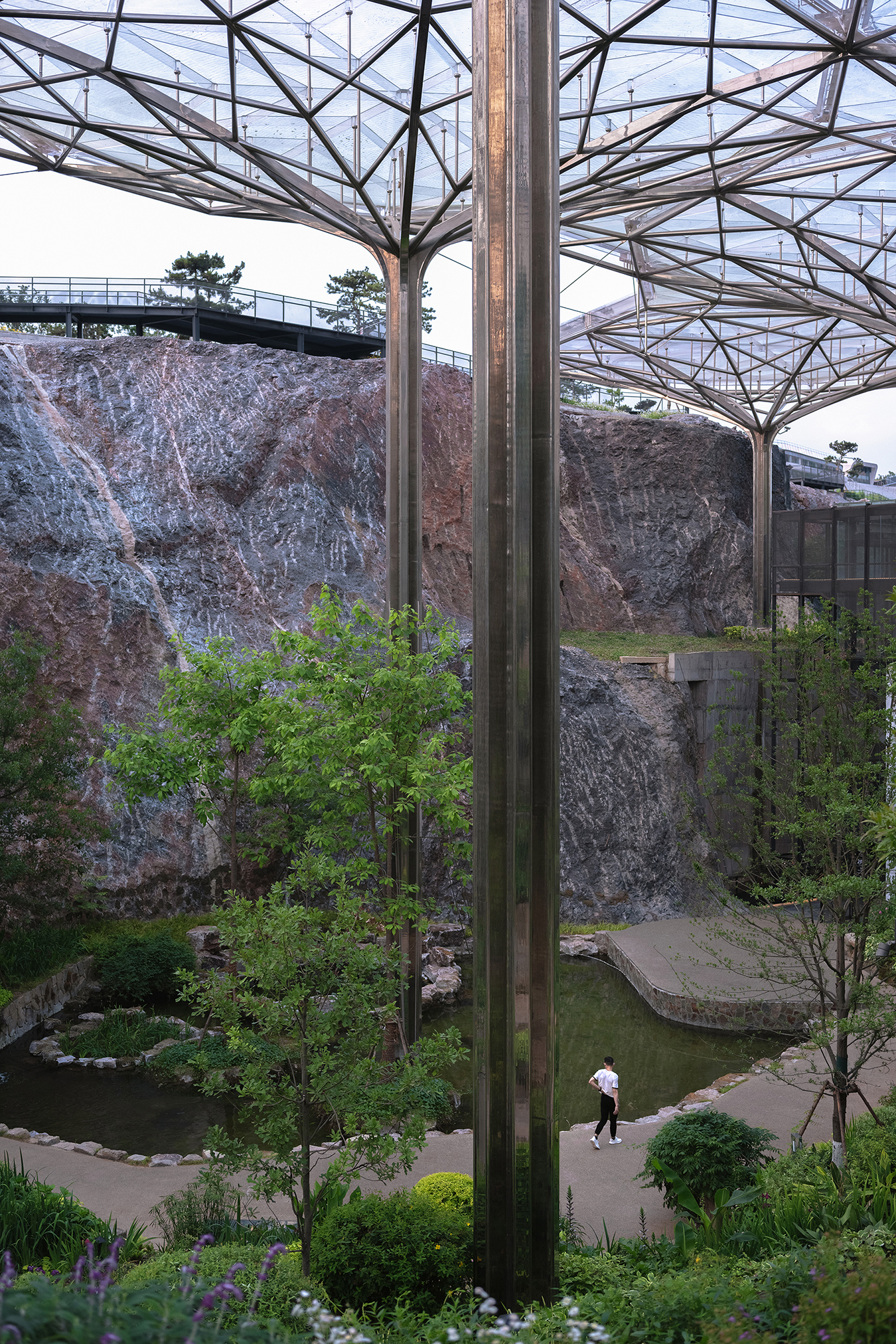 崖壁与花园 摄影:Holi河狸景观摄影
崖壁与花园 摄影:Holi河狸景观摄影设计单位 北京多义景观规划设计事务所、北京林业大学园林学院
项目地点 江苏南京
建成时间 2021年9月
设计面积 196,000平方米
位于南京郊区的一片棕地,因举办园林博览会而被修复,并在展会后转变为一个旅游度假区。项目以这片棕地中的一个大型采石坑为基址,规划为拥有酒店、植物园、餐厅、咖啡馆、室外剧场等功能的、以再生采石场为主题的旅游综合体。项目的挑战不仅来自于采石坑被严重破坏的自然环境,还来自于功能和目标的复杂性。设计针对采石场不同部分的地质条件和景观特征,采取了不同的修复方式,在创造新景观的同时保留了场地历史的记忆。在研究了场地的日照、通风、排水等条件的基础上,设计团队选择了800多种植物形成了12个主题植物区,展现了生态修复的可能性和植物多样性,为公众自然教育提供了机会。项目提供了多种复合功能,将消极荒芜的矿坑转变为充满活力的旅游度假综合体,创造了极高的生态价值、经济价值、社会价值。
A brownfield on the outskirts of Nanjing was restored by convening a garden exposition and thereafter is transforming into a tourist resort. The project is located in a large quarry of the brownfield and is planned to be a tourist complex themed by regenerated quarries, which includes a hotel, botanical garden, restaurant, café and outdoor theater. The project faced challenges not only from the severely damaged natural environment of the quarry, but also from the complexity of the project's functions and goals. The proposal adopts differentiated restoration approaches in consideration of the geological conditions and landscape characteristics of different parts of the quarry, creating a new landscape while retaining the memory of the site's history. On the basis of researching conditions onsite like sunlight, ventilation and drainage, the design team chose more than 800 species of plants to form 12 thematic plant areas, which showcases the eco-restoration possibility and plant diversity and provides an opportunity of natural education for the public. It also provides a variety of complex functions to transform a negatively barren quarry pit into a vibrant tourist resort complex, creating high ecological, economic and social value.
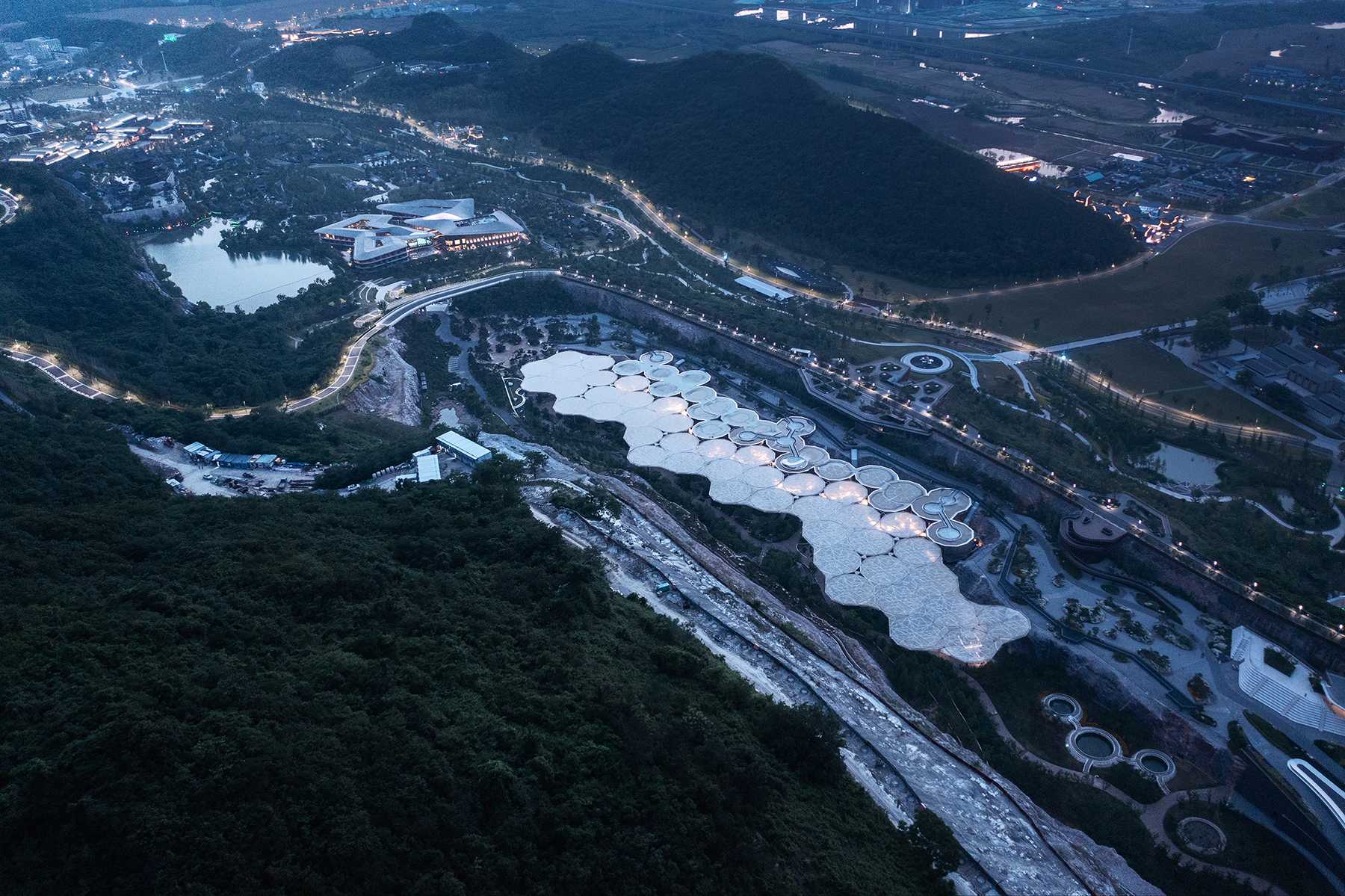 未来花园鸟瞰 摄影:Holi河狸景观摄影
未来花园鸟瞰 摄影:Holi河狸景观摄影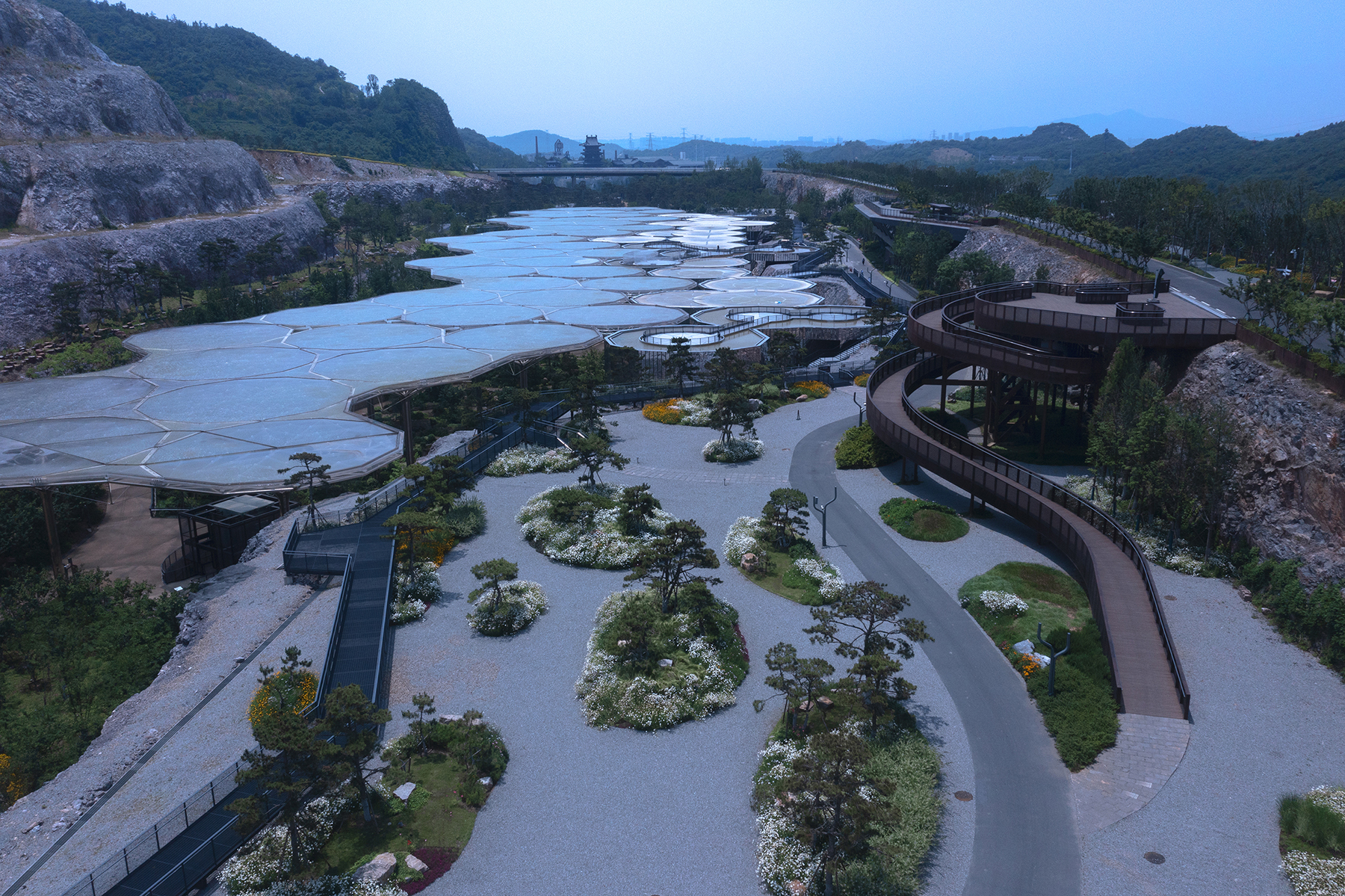 未来花园是废弃采石场的重生 摄影:Holi河狸景观摄影
未来花园是废弃采石场的重生 摄影:Holi河狸景观摄影汤山地区拥有优质的温泉,在约1500年前就是皇家的温泉疗养地,古迹、温泉和良好的自然环境使其时至今日仍然是南京郊区的一个度假地。不过,20世纪60年代,该地区北部的一些石灰岩山体被开采作为水泥制造原料,水泥厂也在山脚建成。到2018年,南京市政府决定关闭这些采石场和水泥厂,并通过举办园林博览会,修复自然环境、改造工业设施、建造舒适的旅游服务设施,将这片棕地转变为旅游度假区。
The Tangshan area, provided with its natural premium hot springs, was a royal spa 1,500 years ago. Today, it remains a resort on the outskirts of Nanjing today due to its monuments, hot springs and good natural environment. Nevertheless, in the 1960s, some limestone hills in the northern part of the region were mined as raw material for cement, as a result plenty of cement plants were built at the foot of the hills. By 2018, the Nanjing government decided to close these quarries and cement plants and transform this brownfield into a tourist resort by restoring the natural environment, regenerating industrial facilities,building comfortable tourist facilities and hosting the garden exposition.
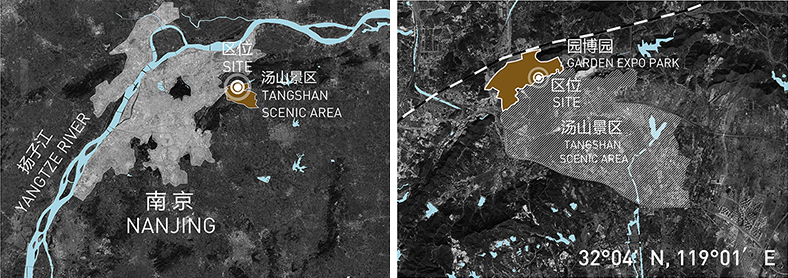
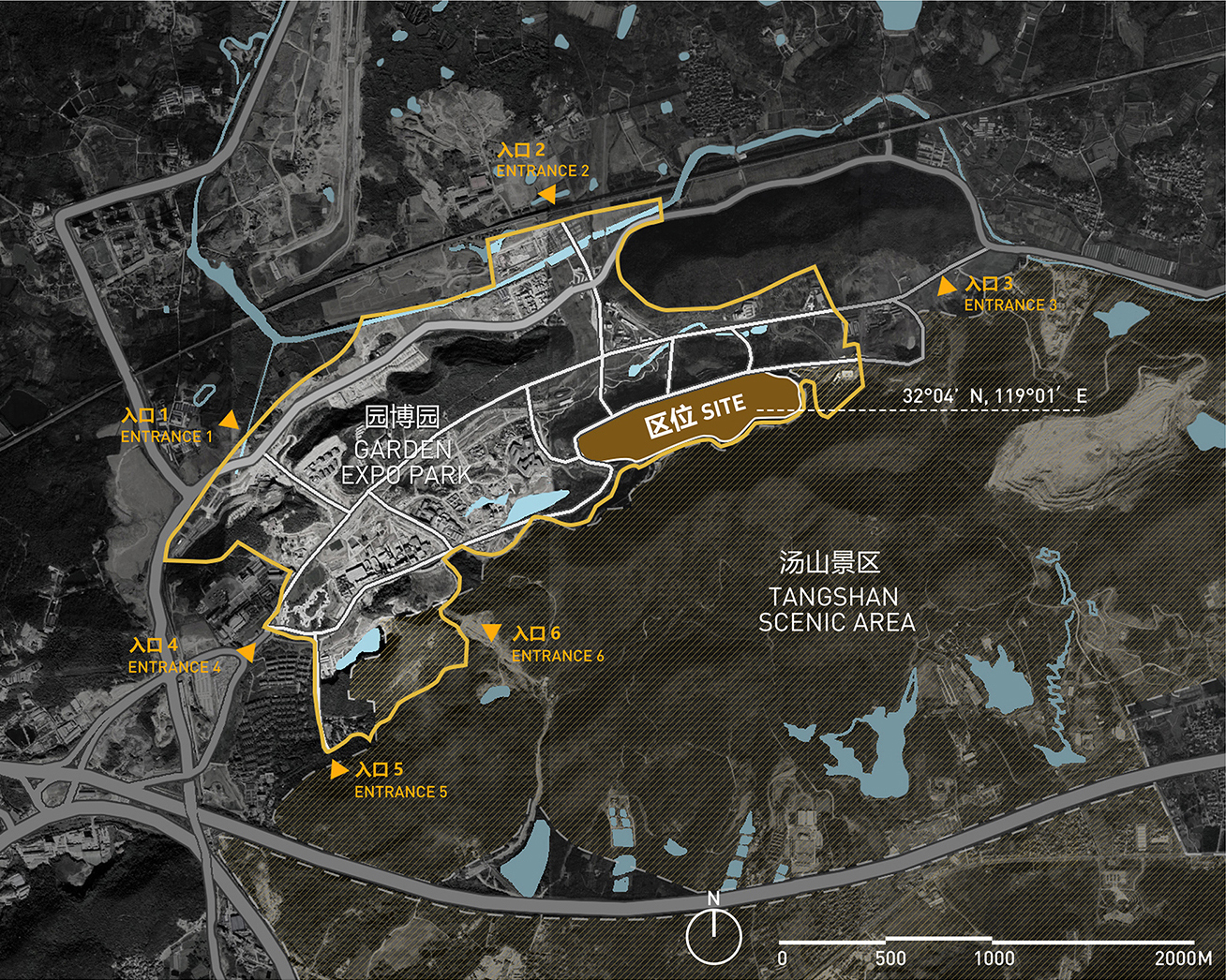 项目区位 ©多义景观+北林园林学院
项目区位 ©多义景观+北林园林学院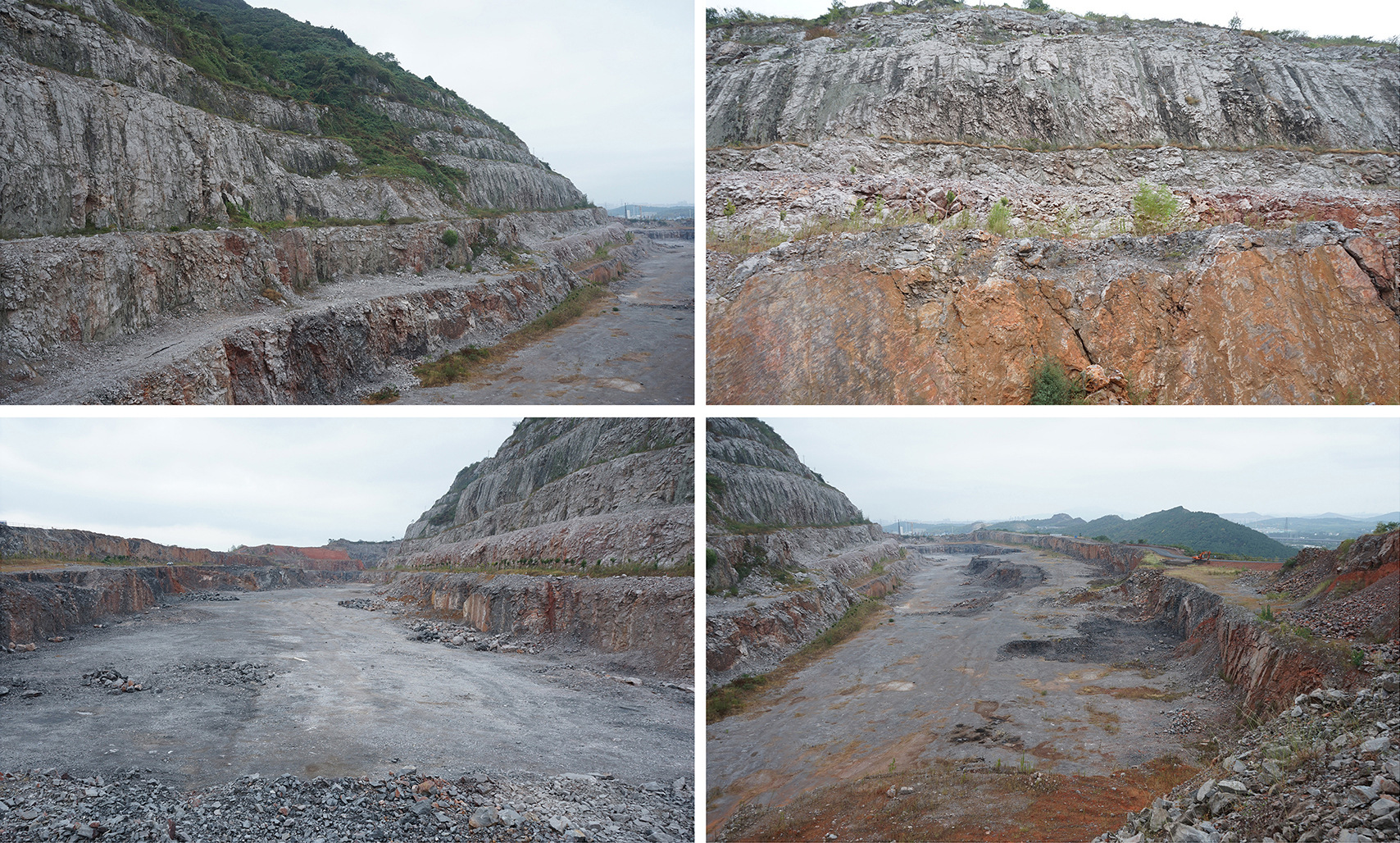 采石场原状 摄影:王向荣
采石场原状 摄影:王向荣场地在此次规划的园博园范围内,位于半山腰上,曾经是南京最大的采石坑,长1100米,有两层,深度10—22米,总面积达25.5公顷。
The site that lies on a hillside within the planned garden expo used to be the largest quarry in Nanjing, 1,100m long and 10-22m deep, with two levels, covering a total area of 25.5 hectares.
业主希望未来花园能够不仅仅是园博会的一个展区,满足园林园艺展览的需求,还需要具有持久的魅力和商业运营的可能,在会后成为有吸引力的旅游目的地。于是,这里被规划成含矿坑主题酒店、植物园、餐厅、咖啡、室外剧场等为一体的以再生采石场为主题的旅游综合体。
The client hoped Future Garden to be more than just a show place meeting the needs of exhibition, but also to own lasting charm and the possibility of commercial operation, becoming an attractive tourist destination after the expo. It was therefore planned as a tourism complex themed by regenerated quarries, which includes hotel, botanical garden, restaurant, café and outdoor theater.
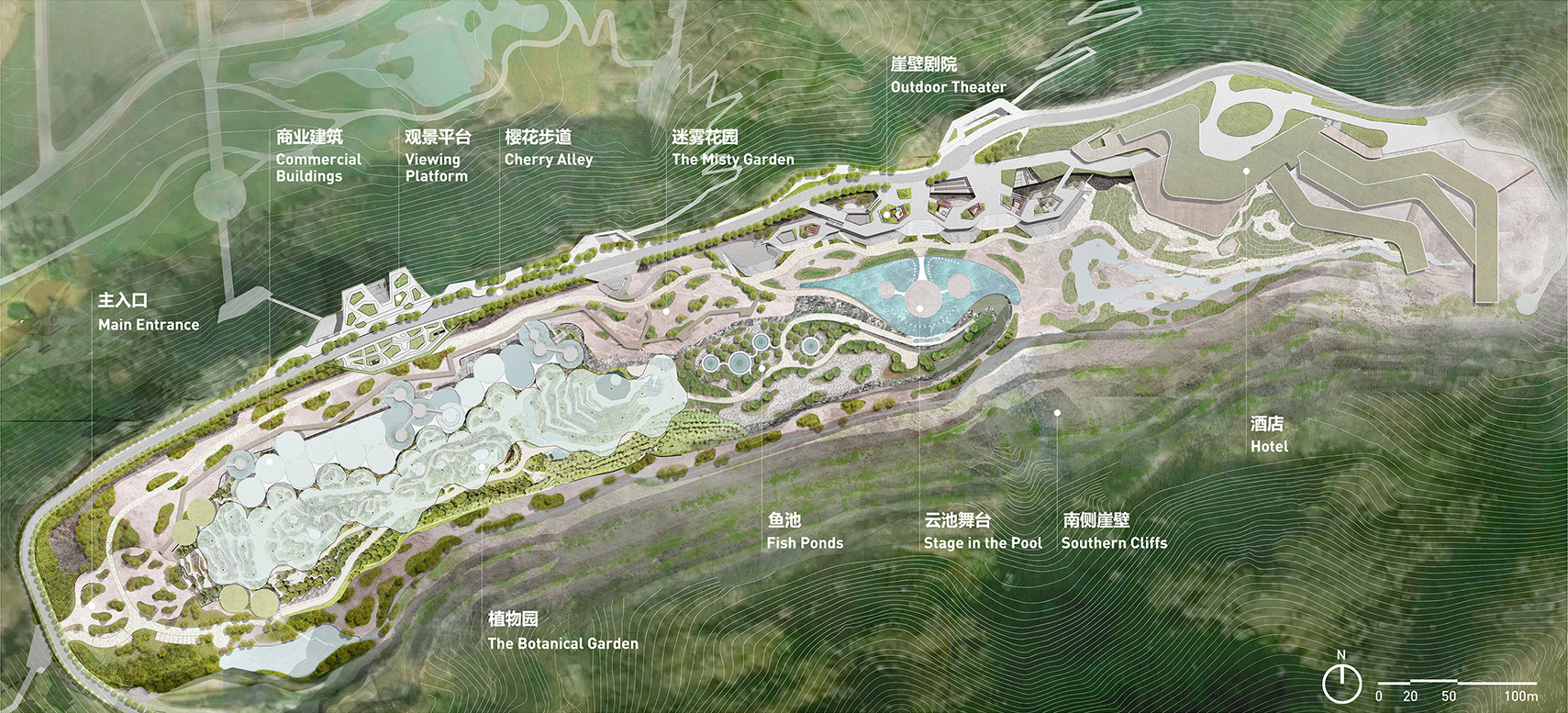 总平面图 ©多义景观+北林园林学院
总平面图 ©多义景观+北林园林学院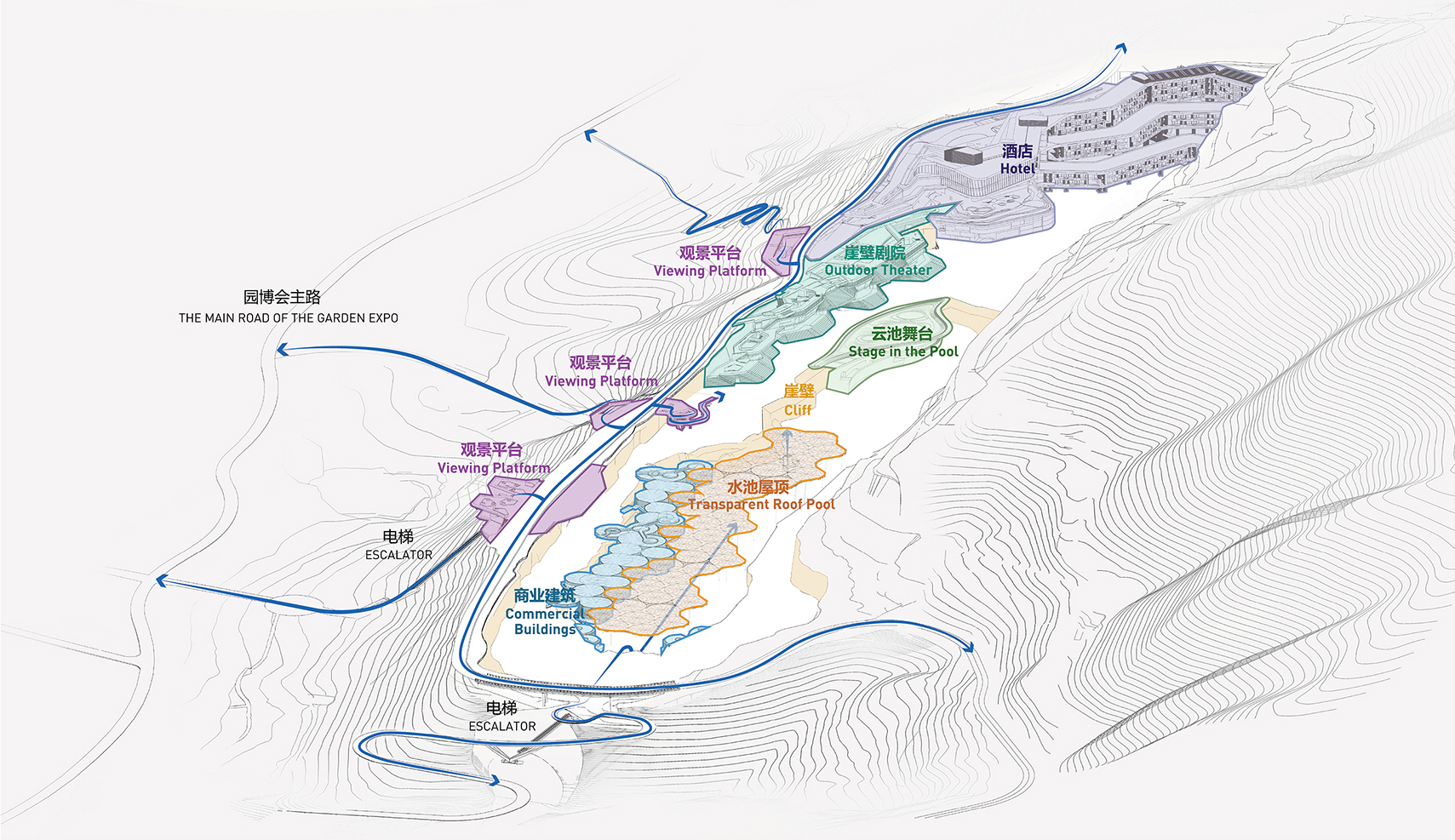 构筑物和交通流线 ©多义景观+北林园林学院
构筑物和交通流线 ©多义景观+北林园林学院项目的挑战不仅仅来自于采石坑本身被严重破坏的自然环境,还来自于项目功能和目标的复杂性。矿坑的东侧是酒店,紧邻酒店是一个大型室外剧场,夜晚这里会举办以悬崖为背景的舞台演出和灯光秀。底层的采石坑被规划为观赏美丽的植物和鱼的空间。矿坑北侧边缘,朝向园博园以及矿坑内部设计了几个观景平台。一系列台阶、坡道和自动扶梯连接矿坑内外不同的层级。景观设计一方面要修复矿坑、创造有特色的景观,成为旅游度假区有吸引力的景点;另一方面,要满足建筑复杂的消防、人流集散、设备安装等要求,并将不同类型的建筑融合在景观中。
The project faced with challenges not only from the severely damaged natural environment of the quarry, but also from the complexity of project's functions and goals. To the east of the quarry is a hotel, and adjacent to the hotel lies a grand outdoor theater hosting stage performances and light shows at night with cliff as a backdrop. The bottom of the quarry is planned as a space for ornamental plants and beautiful fish. Several viewing platforms are arranged on the northern edge of the pit towards the main area of the expo and the interior of the quarry respectively. A series of steps, ramps and escalators connect different levels inside and outside. The proposal aims to restore the quarry and create a characteristic landscape that would become an attraction of the resort area on the one hand. On the other, it is to meet the complex requirements of the buildings for fire fighting, flow gathering and circulation and equipment installation, meanwhile to integrate different types of buildings in the landscape.
 入口区绿道内种植高大的松树 摄影:Holi河狸景观摄影
入口区绿道内种植高大的松树 摄影:Holi河狸景观摄影 植物园在巨型的透明水池屋顶下面,仿佛是隐藏于水下的伊甸园 摄影:Holi河狸景观摄影
植物园在巨型的透明水池屋顶下面,仿佛是隐藏于水下的伊甸园 摄影:Holi河狸景观摄影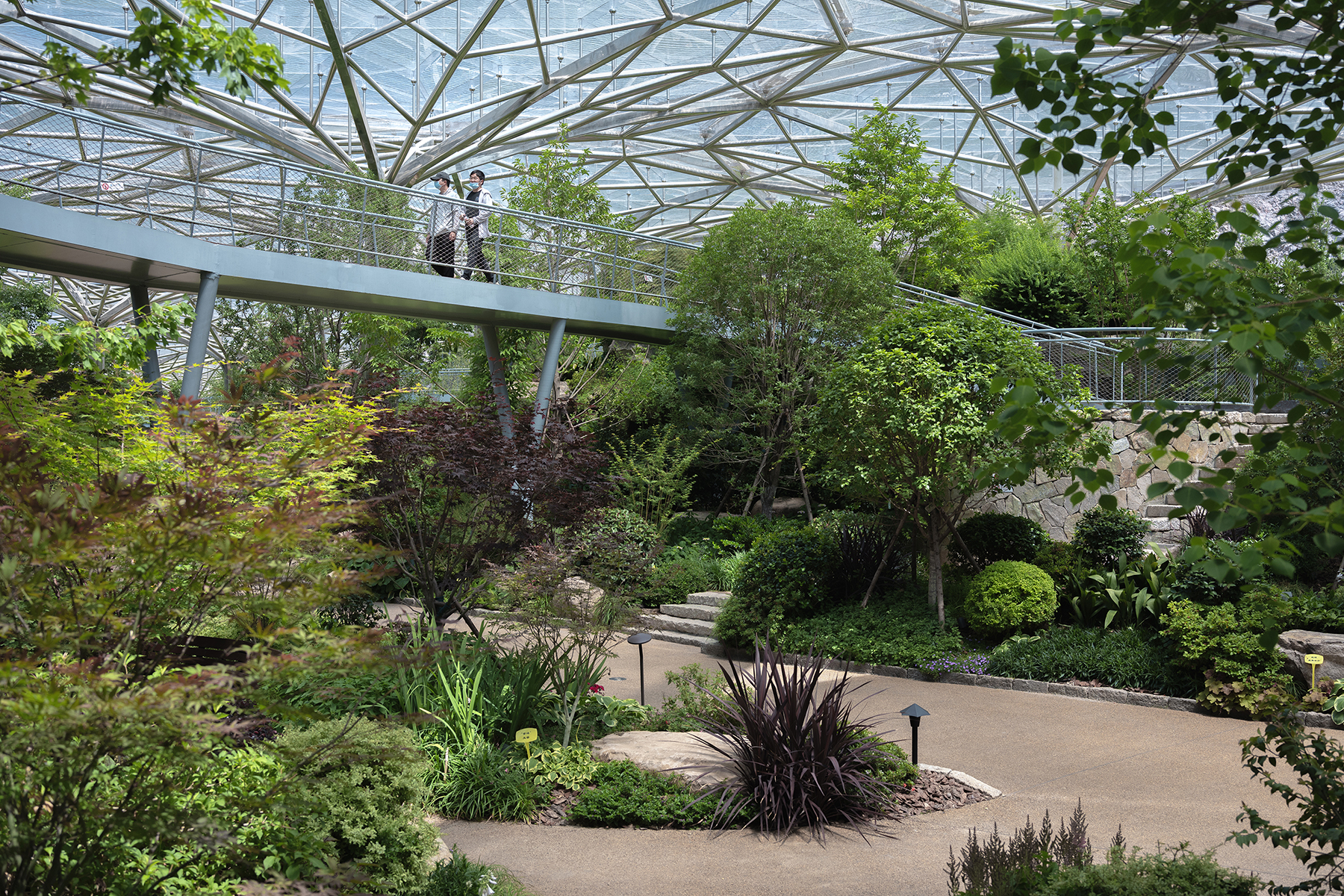 植物园中起伏的丘陵、幽深的峡谷和陡峭的岩石创造了丰富的空间变化,也为不同植物创造了合适的生长环境 摄影:Holi河狸景观摄影
植物园中起伏的丘陵、幽深的峡谷和陡峭的岩石创造了丰富的空间变化,也为不同植物创造了合适的生长环境 摄影:Holi河狸景观摄影植物园是项目的核心,位于底层采石坑的西侧,北侧紧邻崖壁有一组二层的商业建筑,包含咖啡馆、餐厅、展览等功能。为了营造梦幻的效果,建筑师将植物园屋顶设计成一个巨型的透明水池,用42根高大的不锈钢树状结构柱支撑,阳光穿过水面和透明屋顶洒在植物园中,映照出一片生机勃勃的绿色世界。
As the core of the project, botanical garden is located on the west side of the bottom quarry, with a set of 2-story commercial buildings adjacent to cliff, functioning as café, restaurant, and exhibition. To create a dreamy atmosphere, architects designed the roof of the botanical garden as a giant transparent pool, supported by 42 tall stainless steel tree-like structural columns, with sunlight pouring in through the water and the transparent roof to irradiate a vibrant green world.
 丰富繁茂的植物 摄影:Holi河狸景观摄影
丰富繁茂的植物 摄影:Holi河狸景观摄影 跌水、园路与池塘 摄影:Holi河狸景观摄影
跌水、园路与池塘 摄影:Holi河狸景观摄影通过对光照条件、水分条件和覆土可行性的分析,团队确定将植物园从西到东分为旱生、中生和湿生三个不同的生境区。
The botanical garden is classified as three different habitat zones from west to east namely, arid area, mesic area and humid area through the analysis of sunlight conditions, moisture conditions and earthing feasibility.
光照条件好的岩坡上是旱生花园,同时也是植物园的主入口,有八九米的高差,需要设置台阶和无障碍坡道。层叠错落的岩石台地,将67级台阶和总长86米的之字形坡道巧妙地结合,台地上生长着形态色彩各异的耐旱和耐贫瘠植物。
As the main entrance of botanical garden, arid garden lies on rocky slope with good sunlight conditions. A height difference of 8m requires steps and ramps to be provided. The rocky terraces combine 67 steps and an 86m-long zigzag ramp, on which various drought- and barren-tolerant plants grow.
 旱生花园的台地上生长着形态色彩各异的耐旱和耐贫瘠植物 摄影:Holi河狸景观摄影
旱生花园的台地上生长着形态色彩各异的耐旱和耐贫瘠植物 摄影:Holi河狸景观摄影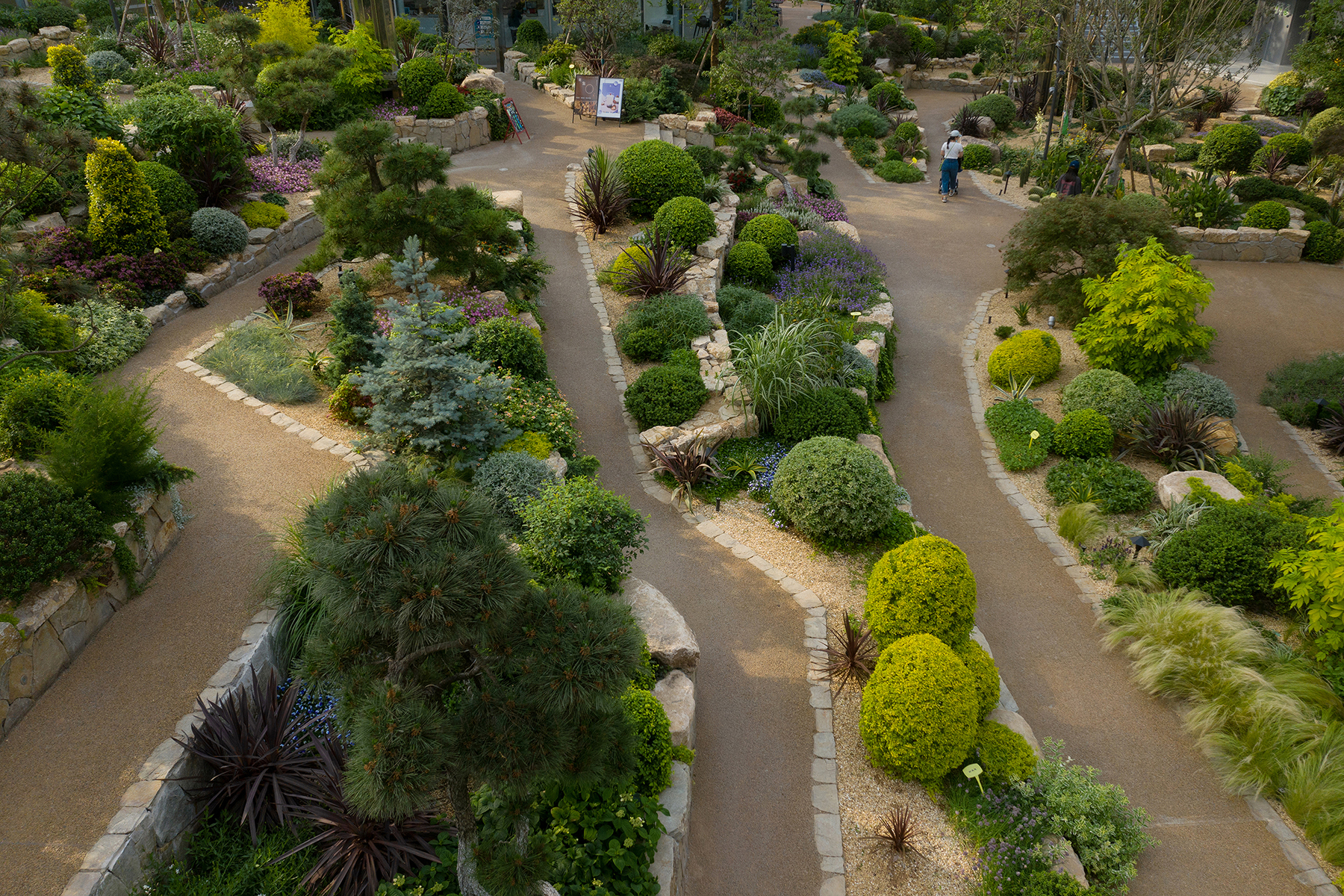 旱生花园中层叠错落的岩石台地,将台阶和之字形坡道巧妙地结合 摄影:Holi河狸景观摄影
旱生花园中层叠错落的岩石台地,将台阶和之字形坡道巧妙地结合 摄影:Holi河狸景观摄影中生花园的设计,通过创造起伏的丘陵、幽深的峡谷、陡峭的岩石,产生了丰富的空间变化,为不同植物创造了合适的生长环境。在复杂的地形中,包含了多个主题的植物展示区,如药用植物、芳香和蜜源植物、孑遗植物、茶饮植物、奇趣植物等区域,以及以不同色彩为主题的花园区。为了增加植物的种类和提高观赏性,还设计有两个小型的暖房,为不能露地过冬的沙漠植物和气生植物提供庇护。一座蜿蜒的空中栈桥,连接了商业建筑二层与花园中的假山和观景平台,提供了在树梢穿越的独特体验和俯瞰花园的视角。
The mesic garden is proposed to create rich spatial variations by shaping undulating landform, deep ravines and steep rocks, offering the suitable environment for different plants to grow. In the complex topography there are several thematic plant display areas, such as areas separately for medicinal plants, aromatic and nectariferous plant, relict plant, tea plants, fantastic plants and plants with different colors. To increase the variety and attraction, 2 small green houses are designed to provide shelter for desert plants and aerophytes that cannot tolerate the winter outdoor. A winding skywalk connects the second floor of commercial building to the rockery and viewing platform in the garden, providing a unique experience of traversing through treetops and overlooking the garden scenery.
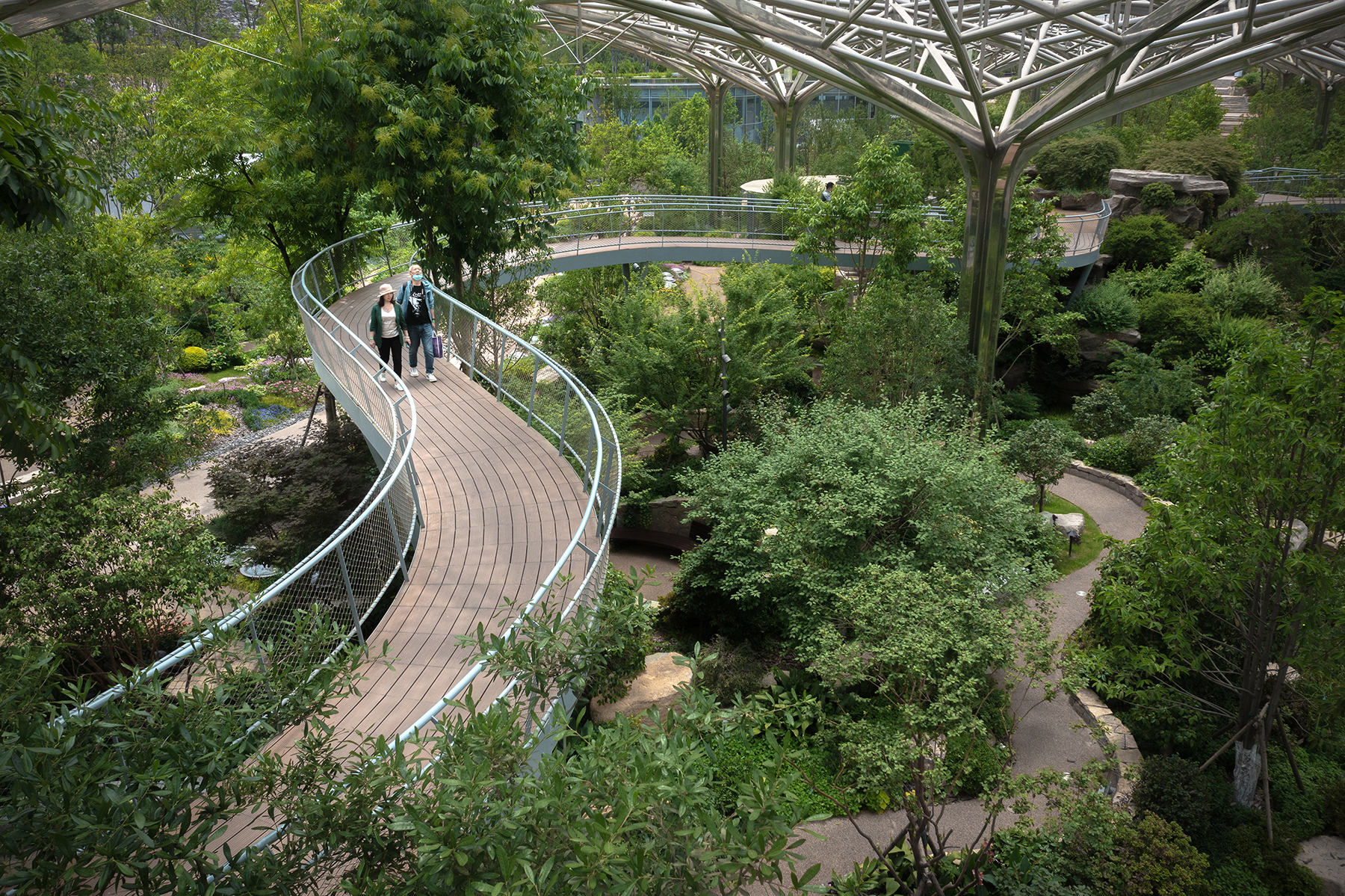 蜿蜒的空中栈桥 摄影:Holi河狸景观摄影
蜿蜒的空中栈桥 摄影:Holi河狸景观摄影 空中栈桥连接了植物园中的商业建筑和观景平台 摄影:Holi河狸景观摄影
空中栈桥连接了植物园中的商业建筑和观景平台 摄影:Holi河狸景观摄影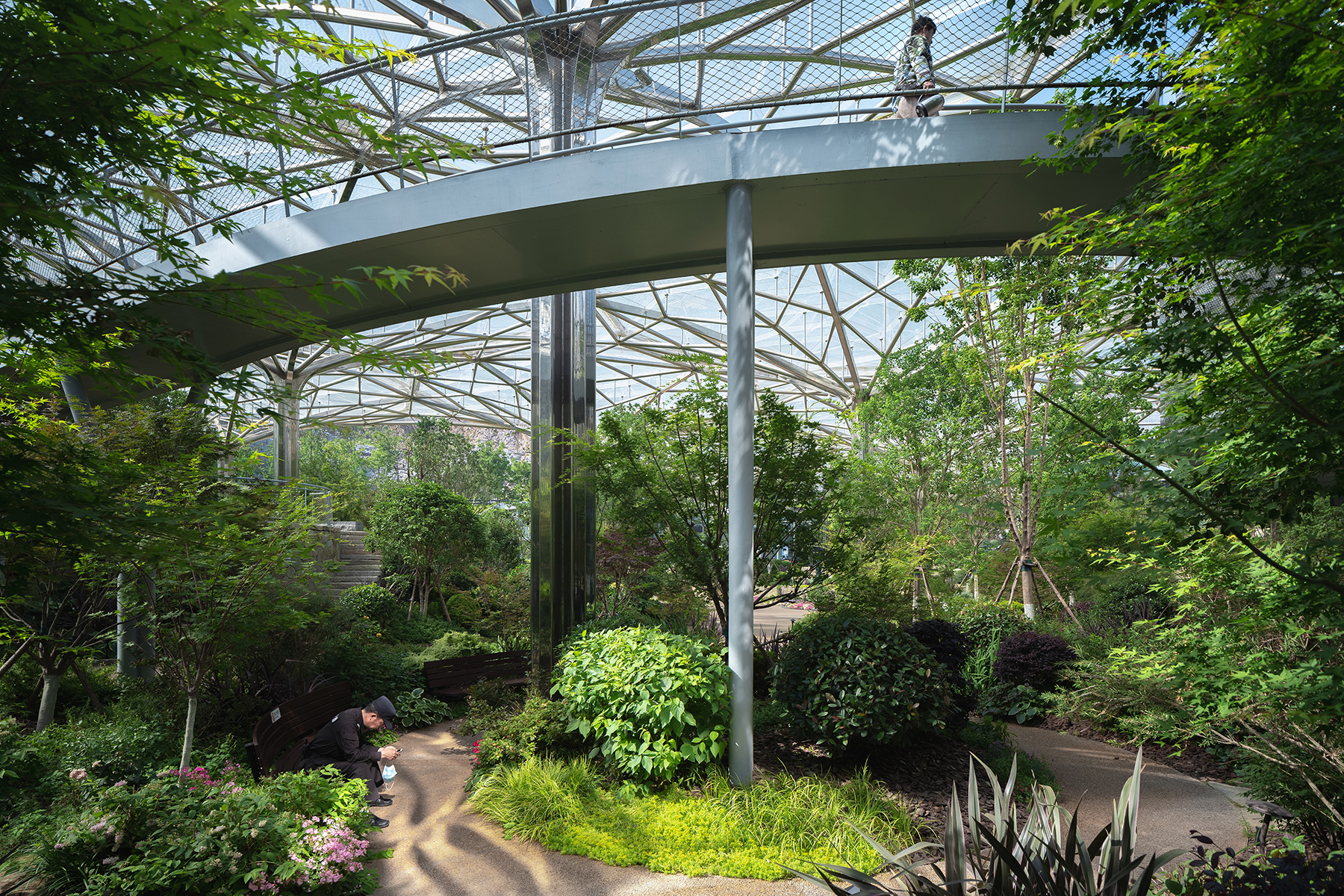 立体的花园空间 摄影:Holi河狸景观摄影
立体的花园空间 摄影:Holi河狸景观摄影湿生花园地势较低,光照条件较差,雨水和岩石渗水会顺应地势流到最低处。湿生花园包含了两部分,一是种植水生植物的池塘,水光潋滟,有栈桥穿越茂盛的水生植物丛;二是为荫生植物设置的下凹区,顺应地形的层层台地和之字形坡道引导着游客进入花园的最低处。台地和坡道边有一条窄窄的石质水渠,水渠底的纹理将水流激荡出小小的水花、引发潺潺的水流声。水渠时而在路左,时而在路右,时而穿越道路,时而潜入花丛。在不同层级的台地边缘,水从石槽上跌落入小水池,呈现闪亮的小瀑布,留下悦耳的水声,然后又沿着下层的水渠继续流淌,最终汇入最低处的水池。每一层台地上和坡道边缘,都生长着大量苍翠润泽的耐湿和荫生植物。水渠、跌水和水池不仅创造了丰富的景观,也增加了环境湿度,为植物的生长创造了更好的条件。
With low-lying position, humid garden has poor sunlight condition, rainwater and water seepage from the rock flow down along the terrain. The garden consists of two parts: the glistening pond with a winding bridge through the lush aquatic flora; and the sunken space as shady plant area, with terraces and a zigzag ramp leading visitors to the lowest part of the garden. There is a narrow stone canal by the side of terraces and ramp, the texture of canal bottom causes small splashes and gurgles of water. The canal runs along or across the ramp, and dives into the flowers. At the edge of the terraces, water drops from the stone troughs into small ponds, presenting small shimmering cascades and leaving pleasant sound, and then continues to flow along the lower canal, eventually joining the lowest pond. On each level of the terrace and on the edge of the ramp are grown many hygrophilous and shady plants. The canals, cascades and ponds not only produce rich landscape, but also increase the humidity and create better conditions for plants.
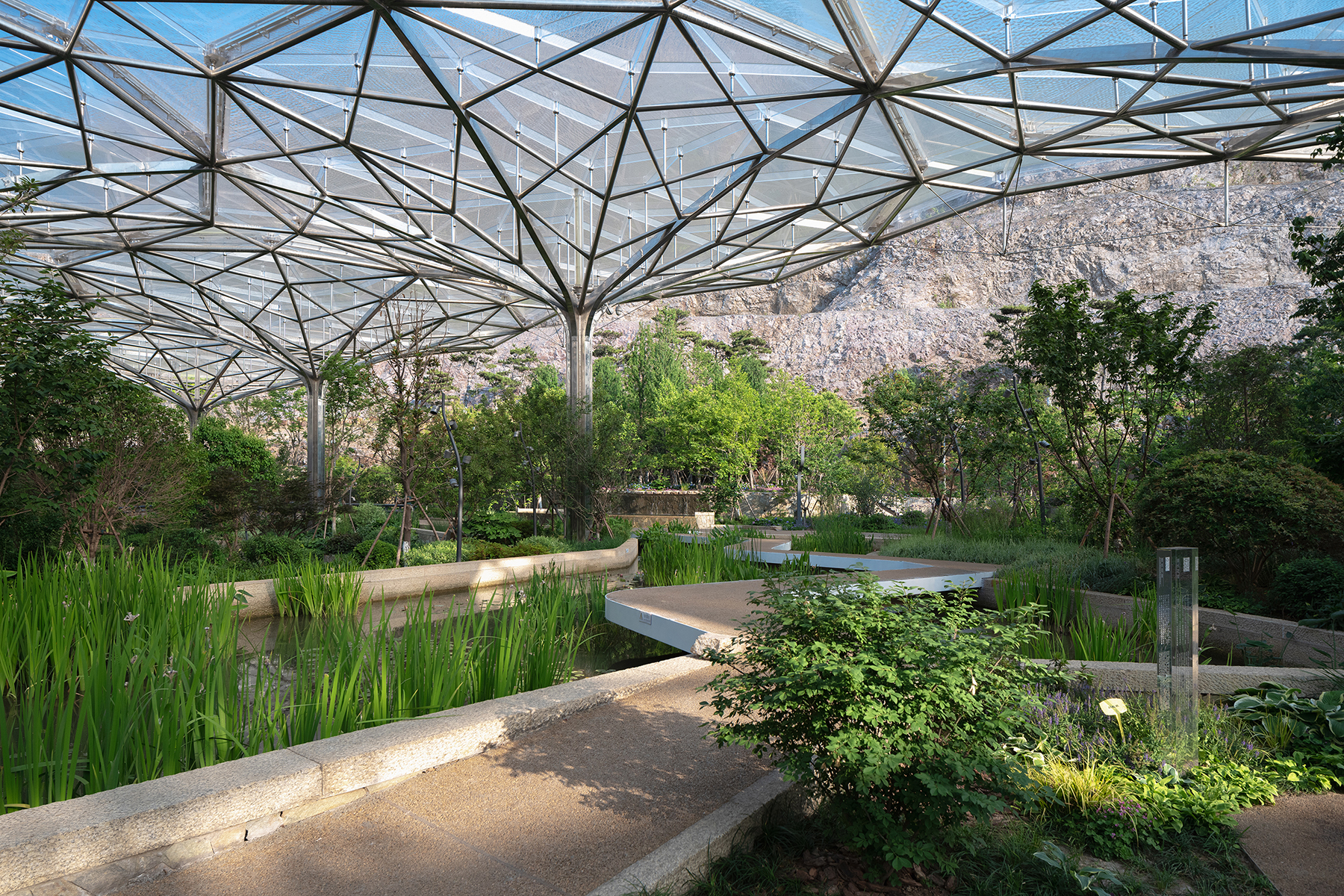 水生植物池塘 摄影:Holi河狸景观摄影
水生植物池塘 摄影:Holi河狸景观摄影 水生植物池塘和通往花园最低处的坡道 摄影:Holi河狸景观摄影
水生植物池塘和通往花园最低处的坡道 摄影:Holi河狸景观摄影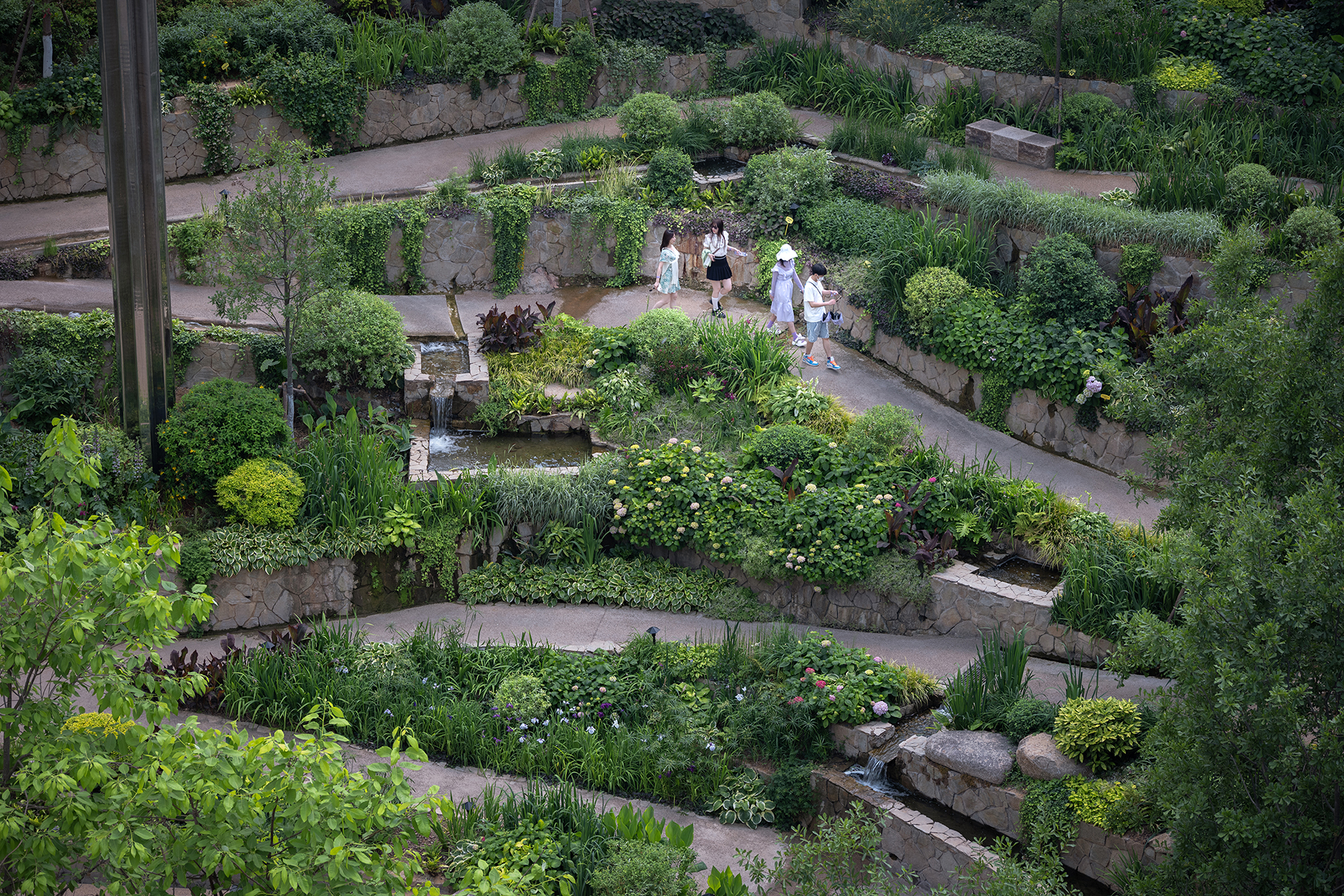 水渠和平台的边缘有一系列小水渠,潺潺的流水增加了景观的趣味 摄影:Holi河狸景观摄影
水渠和平台的边缘有一系列小水渠,潺潺的流水增加了景观的趣味 摄影:Holi河狸景观摄影 水渠、跌水和水池不仅创造了丰富的景观,也增加了环境湿度,为植物的生长创造了更好的条件 摄影:Holi河狸景观摄影
水渠、跌水和水池不仅创造了丰富的景观,也增加了环境湿度,为植物的生长创造了更好的条件 摄影:Holi河狸景观摄影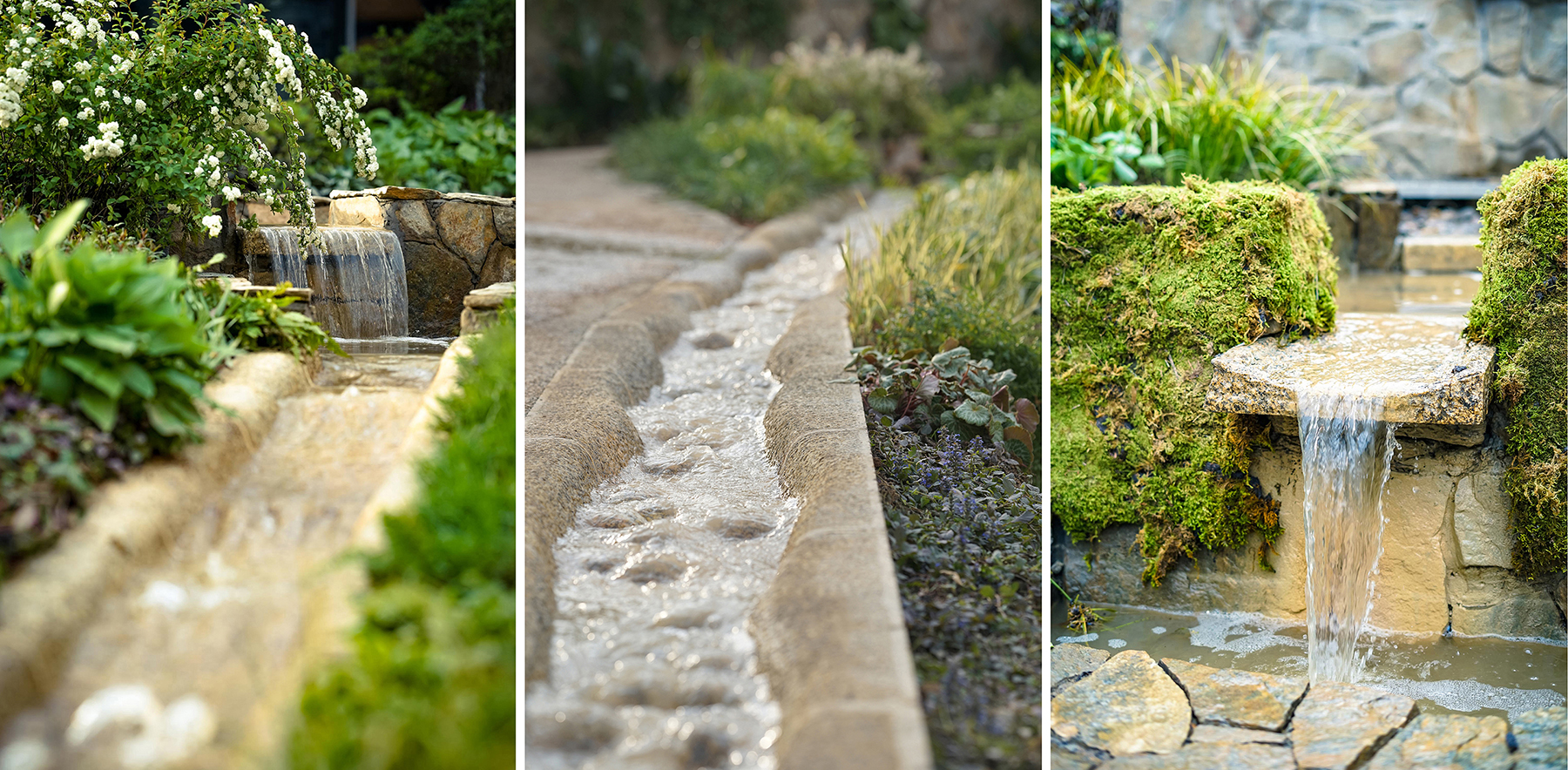 水从石槽上跌落入小水潭,又沿着下层的水渠继续流淌,最终汇入最低处的水池 摄影:姚鸿飞
水从石槽上跌落入小水潭,又沿着下层的水渠继续流淌,最终汇入最低处的水池 摄影:姚鸿飞场地中特意设计的名为“植物泡泡”的微型装置,不仅可以为一些不耐寒的植物提供气候保护,也可以为小型植物提供一个单独展示的机会,还可以作为青少年栽植DIY的种植池,为植物园未来的公众教育和商业运营提供